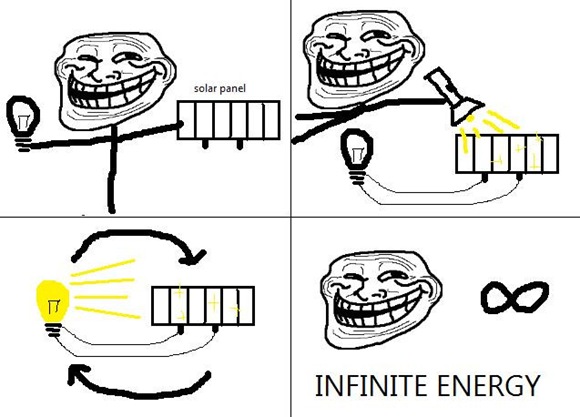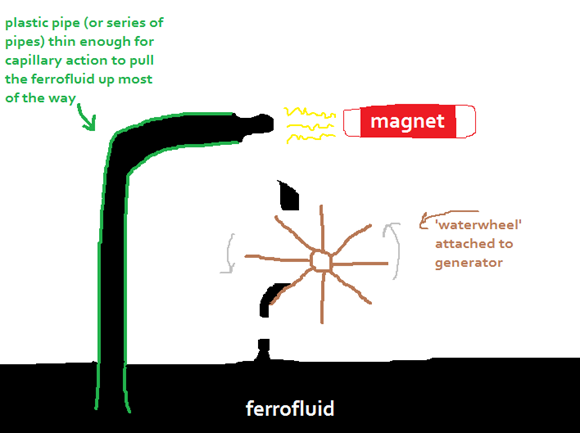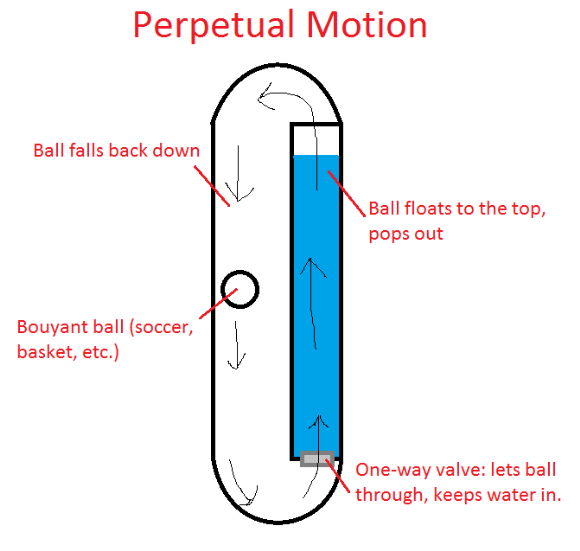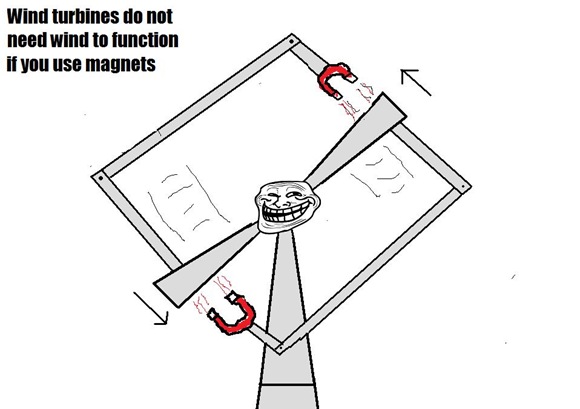1. Free Energy Sail

Why this wouldn’t work:
The force the fan puts on the air (Newton’s Laws, equal and opposite reactions) are put on the fan as well. Because of this, there is no net force on the sail-car, resulting in zero movement. Also, conservation of energy prevents you from recovering the energy of the wind for the fan.
2. Free Energy Flashlight

Why this wouldn’t work:
Solar cells are only about 15% efficient. Light bulbs are even less efficient. Even if you could get a 100% efficient light bulb and a 100% efficient solar cell, you still wouldn’t ever be able to extract a net gain of energy from the system. Even the act of seeing light from the light bulb would necessarily mean that energy was being removed from the system, making the bulb increasingly dim until all the energy was dissipated.
3. Eternal Engine Magnet Car

Why this wouldn’t work:
Similarly to the wind car, this vehicle would not move without violating Newton’s laws of motion. There is an equal force on the arm holding the magnet as on the truck, resulting in no net movement. The intuitive misconception here is that the magnet exerts a one-way force, when in fact there is an equal and opposite force on the magnet.
4. Free Energy Earth

Why this wouldn’t work:
While likely impossible to dig a hole through the earth due to the intense pressures and temperatures involved, this system is subject to magnetic damping that will extract energy from the system over time. This pictured system would produce eddy currents in the conductor due to movements in the magnetic field. The flow of electrons in the conductor would create an opposing magnetic field which would result in the damping of the magnet and cause heat inside of the conductor. The loss of the energy used to heat up the conductor would be equal to the loss of kinetic energy of the magnet.
5. Free Energy Ferrofluid

Why this wouldn’t work:
This one is intuitively difficult to find fault with, and comes the closest of any thus far. However, it will not work and will fail for more practical reasons. Capillary action will not work in the same way with this type of fluid, leading to problems with the ferrofluid moving up the tube. Additionally you would likely have problems with ferrofluid sticking to the magnet instead of falling as depicted in the image.
6. Free Floating Energy

Why this wouldn’t work:
In order for the ball to make it through the valve while keeping the water in, it would be required to overcome friction, removing energy from the system. Additionally, the ball would not just “pop out” of the top and fall back down, additional energy would be required for this to work, leaving the system far from perpetual motion.
7. Free Energy Windmill

Why this wouldn’t work:
This is another case of failing to account for the equal and opposite forces as stated in Newton’s laws of motion. The magnets exert an equal and opposite force on the blades as the blades do on the magnets, resulting in a windmill that does not move.
Via: WellHome

Why this wouldn’t work:
The force the fan puts on the air (Newton’s Laws, equal and opposite reactions) are put on the fan as well. Because of this, there is no net force on the sail-car, resulting in zero movement. Also, conservation of energy prevents you from recovering the energy of the wind for the fan.
2. Free Energy Flashlight

Why this wouldn’t work:
Solar cells are only about 15% efficient. Light bulbs are even less efficient. Even if you could get a 100% efficient light bulb and a 100% efficient solar cell, you still wouldn’t ever be able to extract a net gain of energy from the system. Even the act of seeing light from the light bulb would necessarily mean that energy was being removed from the system, making the bulb increasingly dim until all the energy was dissipated.
3. Eternal Engine Magnet Car

Why this wouldn’t work:
Similarly to the wind car, this vehicle would not move without violating Newton’s laws of motion. There is an equal force on the arm holding the magnet as on the truck, resulting in no net movement. The intuitive misconception here is that the magnet exerts a one-way force, when in fact there is an equal and opposite force on the magnet.
4. Free Energy Earth

Why this wouldn’t work:
While likely impossible to dig a hole through the earth due to the intense pressures and temperatures involved, this system is subject to magnetic damping that will extract energy from the system over time. This pictured system would produce eddy currents in the conductor due to movements in the magnetic field. The flow of electrons in the conductor would create an opposing magnetic field which would result in the damping of the magnet and cause heat inside of the conductor. The loss of the energy used to heat up the conductor would be equal to the loss of kinetic energy of the magnet.
5. Free Energy Ferrofluid

Why this wouldn’t work:
This one is intuitively difficult to find fault with, and comes the closest of any thus far. However, it will not work and will fail for more practical reasons. Capillary action will not work in the same way with this type of fluid, leading to problems with the ferrofluid moving up the tube. Additionally you would likely have problems with ferrofluid sticking to the magnet instead of falling as depicted in the image.
6. Free Floating Energy

Why this wouldn’t work:
In order for the ball to make it through the valve while keeping the water in, it would be required to overcome friction, removing energy from the system. Additionally, the ball would not just “pop out” of the top and fall back down, additional energy would be required for this to work, leaving the system far from perpetual motion.
7. Free Energy Windmill

Why this wouldn’t work:
This is another case of failing to account for the equal and opposite forces as stated in Newton’s laws of motion. The magnets exert an equal and opposite force on the blades as the blades do on the magnets, resulting in a windmill that does not move.
Via: WellHome

